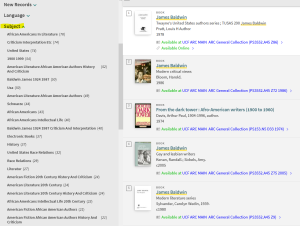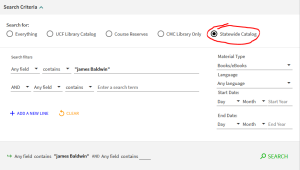Using Primo
Barry Mauer and John Venecek
Primo is the name of the UCF libraries’ online catalog. The key access point is located in the center of the UCF Libraries’ homepage:
Primo provides access to books and e-books as well as media, journals, documents, and other resources owned by the UCF Libraries.To get started, type a title, author, or keyword search in the search bar or select advanced search on the bottom left to get more search options.
Once you’ve conducted you search, you’ll be taken to a results page with a variety of filters to help refine those results in the sidebar on the left. Those filters include availability, location, document type, language, date and so on.
Subject Filter: The subject filter, located in the sidebar on the left, will break your search into more refined subcategories. For example, a basic search on “James Baldwin” yields 531 results.

That’s a lot to wade through, but browsing the Subject limiter will help you focus on the subcategories that most interest you. These could include “African Americans in literature” (76 titles) or “criticism and interpretation” (74 titles).
Format Filter: Use the format limiter to select books or whatever format you are most interested in. Using these limiters will help you quickly navigate Primo to locate the sources that are most useful to you.
Virtual Browse: One of the new Primo features is virtual browse, which allows you to see books related to your search. For example, the catalog record for the book James Baldwin: A Critical Study features a visual scroll at the bottom of the record for the following related titles:
Searching the Statewide Catalog: You can also view and request items available at libraries throughout Florida by clicking the Statewide Catalog link at the top right of the page above the search bars:

This will show the results that can be requested from other libraries via our Inter-Library Loan service. To request an item, simply open the record, sign in with your NID, and follow the prompts to request the item:
This is a fast and easy way to expand your search beyond what is owned by UCF, which will make your literature review more comprehensive.
To see how all this works together, watch this short video tutorial:
Primo Search: Basic Search [3 min 50 sec]
For more advanced Primo search tips, see the series of short videos on the UCF Libraries’ Vimeo site.

